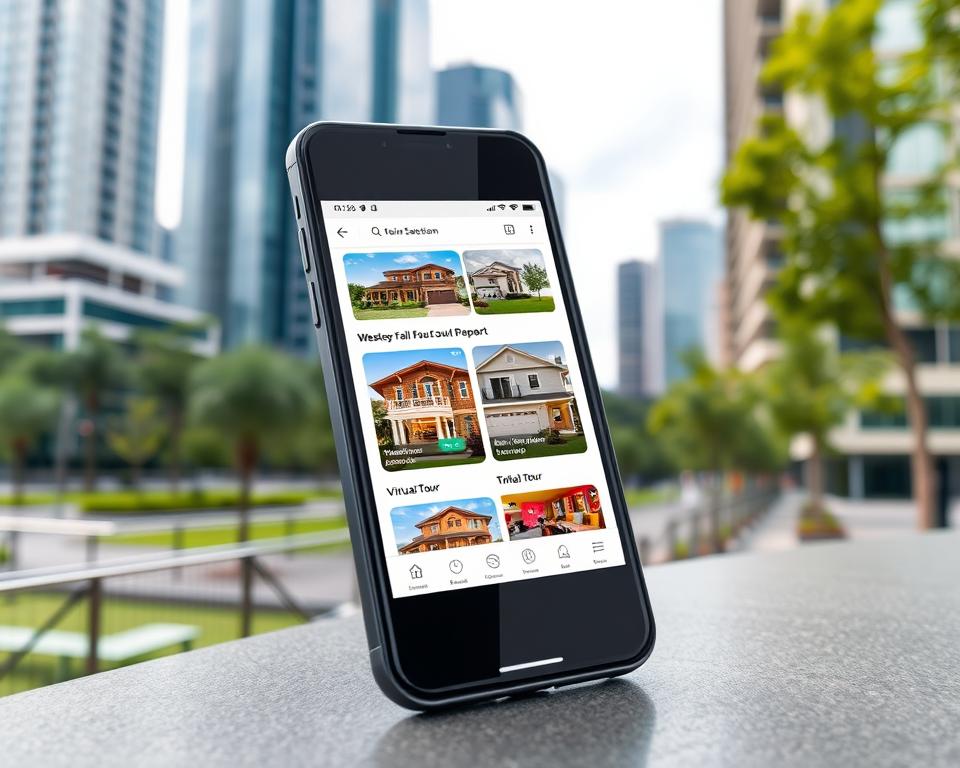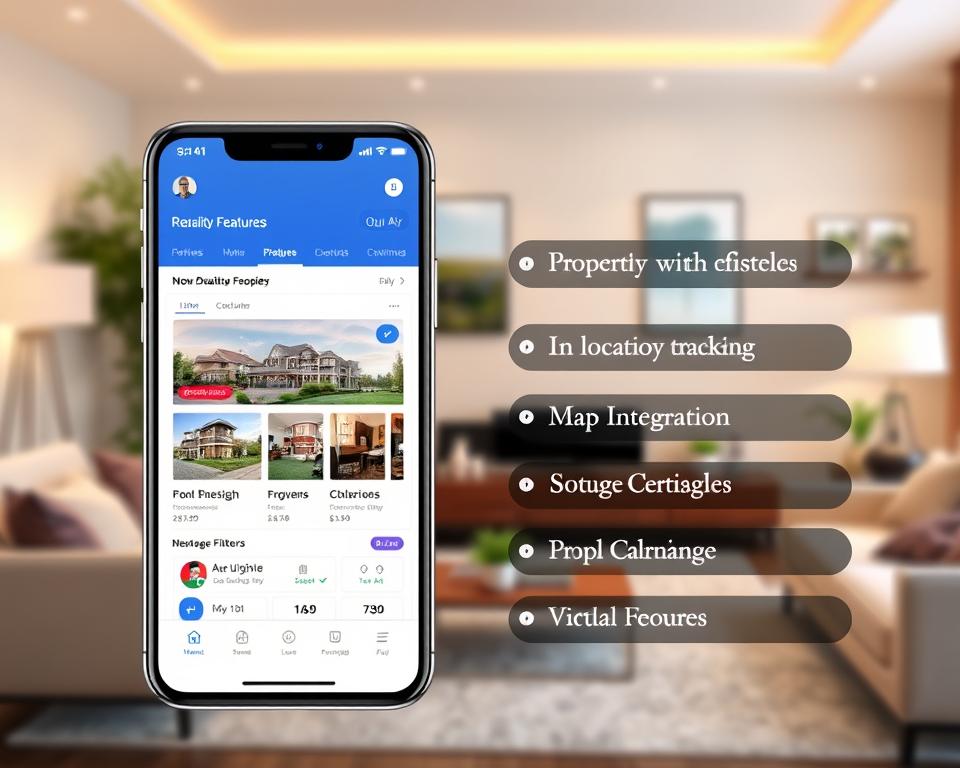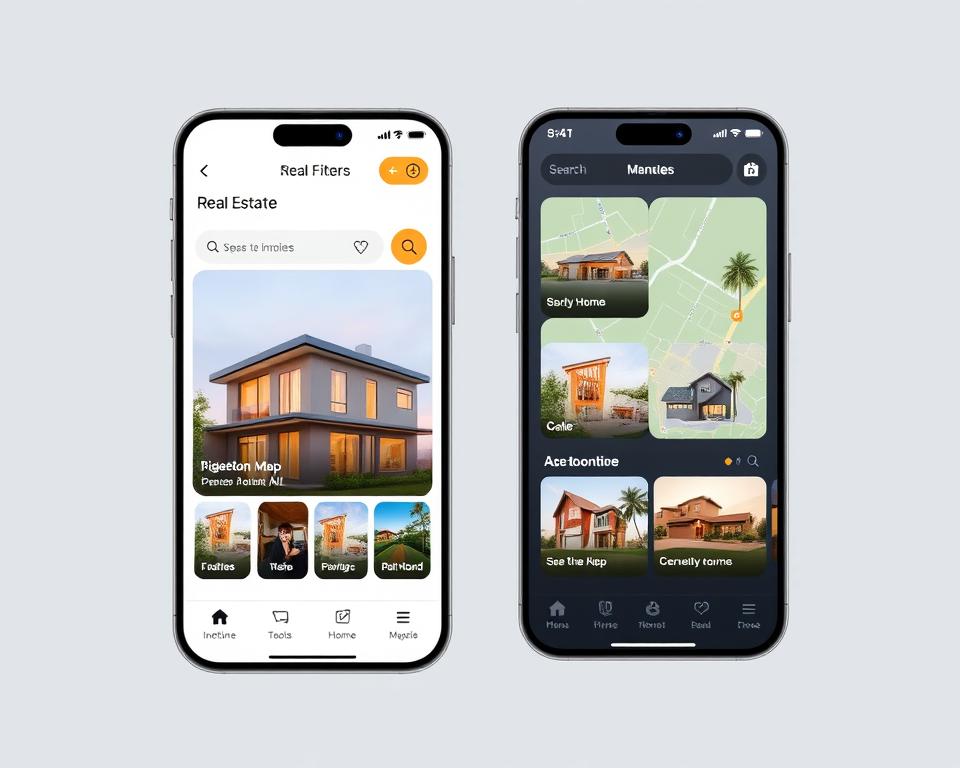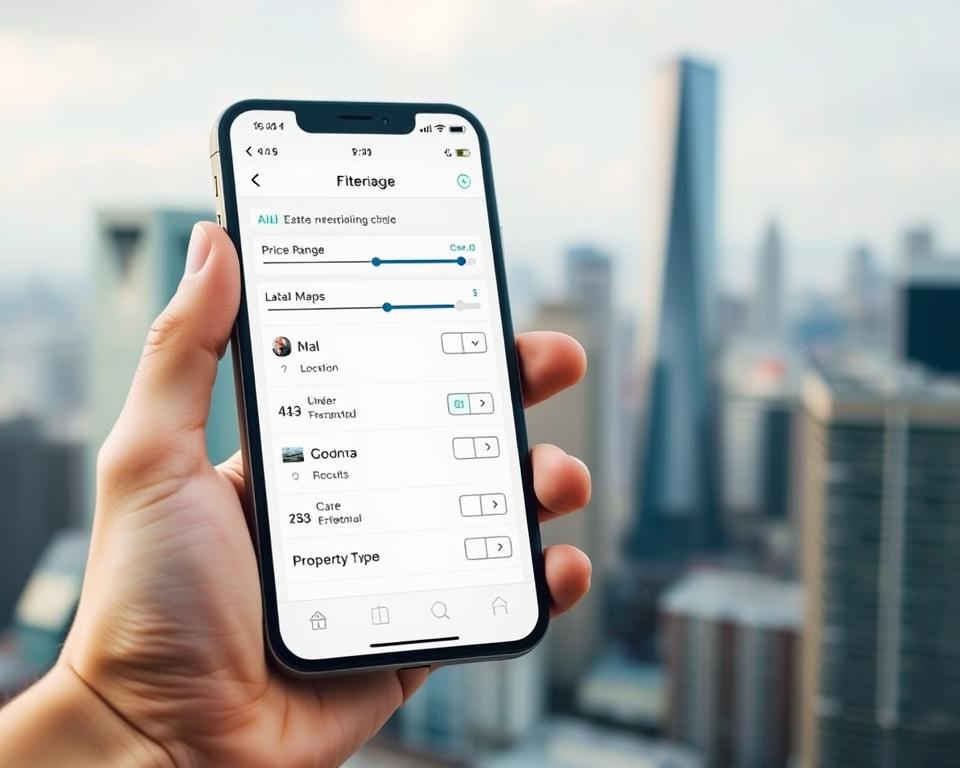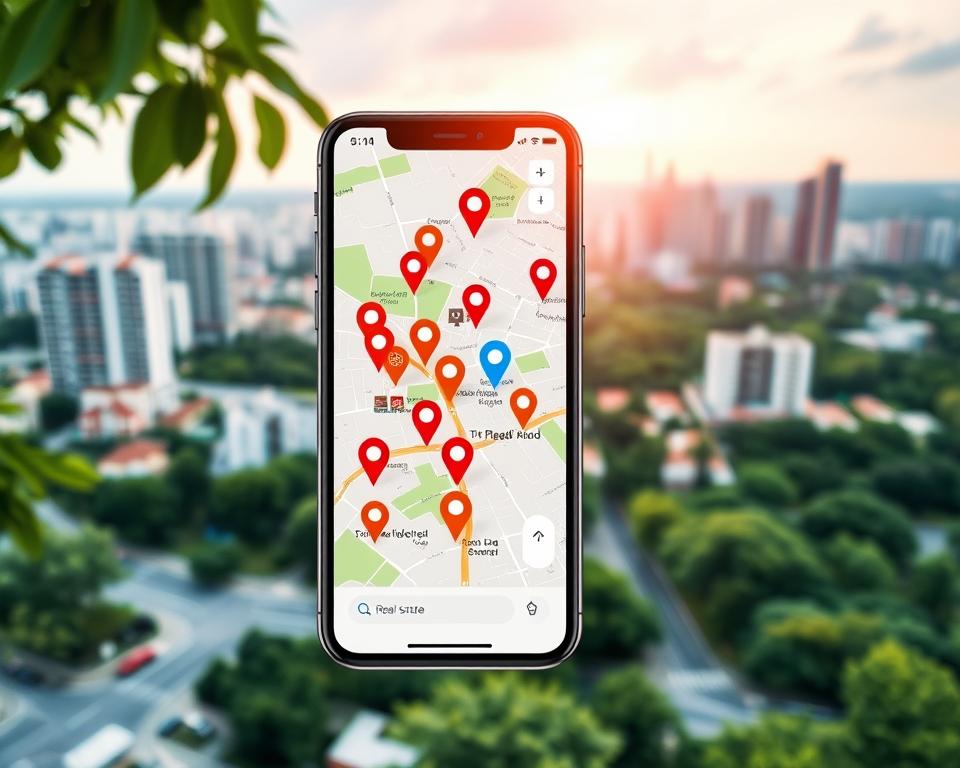In today’s digital world, the real estate industry has changed a lot. Mobile apps are key in changing how we find, manage, and sell properties. A good real estate app can make a big difference for your business. It gives users a smooth experience.
This guide will show you how to make a real estate app that meets today’s market needs. It will cover all the important steps to create a successful app.
Table of Contents
Key Takeaways
- Understand the current real estate app market trends and competitive landscape
- Identify the essential features that should be incorporated into your real estate mobile app
- Explore the step-by-step process of developing a real estate mobile app, from planning to launch
- Discover the optimal technology stack for building a high-performing real estate app
- Implement user-centric design principles to enhance the app’s usability and appeal
Understanding the Real Estate App Market Landscape
The real estate industry has seen big changes lately, thanks to new mobile apps. More people want easy ways to find and explore properties. This has made the real estate app market very competitive, with many different companies trying to succeed.
Current Market Trends and Statistics
Reports show the global real estate app market is growing fast. This is because more people use smartphones and want to buy or invest in homes. The market is expected to hit $15 billion by 2025, showing a lot of potential for new tech in real estate.
Key Players and Competitors Analysis
Big names like Zillow and Realtor.com lead the market. But new startups and apps are changing things. Knowing what each company does well is key for new developers wanting to stand out.
Market Opportunities and Challenges
Real estate apps are popular, but they face challenges. Developers must deal with rules, keep data safe, and stand out in a crowded field. But the rewards are big, as the market keeps growing to meet changing needs.
| Top Real Estate App Competitors | Key Features | Market Share |
|---|---|---|
| Zillow | Comprehensive property search, agent-client communication, mortgage tools | 40% |
| Realtor.com | Detailed property listings, market analysis, agent directory | 30% |
| Redfin | AI-powered property recommendations, virtual tours, seamless transactions | 15% |
| Trulia | Neighborhood insights, mortgage calculators, property comparison tools | 10% |
| Homesnap | AR-enabled property visualization, agent-client collaboration, market trends | 5% |
“The real estate app market is a dynamic and rapidly evolving space, presenting both challenges and immense opportunities for innovative developers.”
Essential Features for Your Real Estate Mobile App
Creating a top-notch real estate mobile app needs careful planning. It must include key features for both buyers and sellers. This way, developers can make an app that’s easy to use and helps with searching, listing, and connecting with properties.
The heart of a great app is its property listing functionality. Users should find it simple to explore a wide range of listings. These listings should have all the details, great photos, and virtual tours. Also, having search and filtering options lets users narrow down their search by location, price, and more.
The app should also have maps and geolocation services. This lets users see properties on a map and explore areas. Adding user profiles and push notifications makes the app more engaging. Users can save favorite properties, get updates, and talk to agents right in the app.
By focusing on these key features, developers can build an user-friendly real estate app. This app makes finding and engaging with properties easier. It leads to happier users and success in the real estate world.
How to Develop a Realestate Mobile App: Step-by-Step Process
Creating a top-notch real estate mobile app takes careful steps. From the first idea to the app’s launch, each step is vital. Let’s look at the main stages of the real estate app development process.
Planning and Research Phase
The first step is app planning. This means doing deep market research and understanding trends. You also need to know what your users want. This helps you make your app unique in the real estate world.
Design and Development Stages
After planning, it’s time for mobile app design and development. You’ll work on making the app easy to use and full of cool features. It’s important to have skilled designers and developers to make your app look good and work well.
Testing and Launch Preparation
Before you launch, you must test your app. This ensures it works smoothly and without bugs. You’ll also gather feedback and make any needed changes. Getting ready for launch means having a solid marketing plan and a way to keep your app updated.
By following these steps, you can overcome the challenges of making a real estate app. You’ll create a great mobile experience for everyone involved in real estate.
Choosing the Right Technology Stack
Choosing the right technology stack for a real estate mobile app is crucial. It affects the app’s performance, scalability, and user experience. When exploring real estate app tech stack, think about your app’s needs and the mobile app development tools available.
Deciding between native app development and cross-platform development is key. Native apps perform well on specific platforms but cost more and require separate codebases. Cross-platform frameworks like React Native or Flutter offer cost savings and faster deployment but might lack some platform-specific features.
For the backend, consider Node.js, Ruby on Rails, or Python frameworks like Django or Flask. These technologies provide strong APIs, database integration, and scalable infrastructure. They support your app’s features and user needs.
When it comes to databases, MongoDB, PostgreSQL, or Firebase are good choices. They depend on your data model’s complexity and the need for real-time updates or offline use.
The right real estate app tech stack choice depends on your budget, team expertise, scalability needs, and app features. By carefully choosing your tech stack, you can build a standout real estate mobile app.
User Interface Design Principles for Real Estate Apps
Making a user interface (UI) that’s easy to use and looks good is key for real estate apps. Following established design rules helps developers make an app that works well for everyone. This includes both people looking to buy homes and real estate agents.
Navigation and User Flow
A good navigation system is the base of a user-friendly app. It should help users find and interact with properties easily. This means fewer steps to do common tasks. A clear menu, easy-to-follow signs, and organized info make the app better to use and less frustrating.
Visual Elements and Branding
The look of a real estate app should match the brand and look professional. The right colors, fonts, and pictures help show the brand’s identity. They also make the app look good to users. Keeping the brand the same everywhere builds trust and credibility.
Accessibility Considerations
It’s important to make the app accessible to everyone, including those with disabilities. This means using high-contrast colors, adjustable font sizes, and support for screen readers. This way, the app is welcoming and easy for all users.
By focusing on these design principles, developers can make a real estate app that’s easy and fun to use. This leads to happier users and more people using the app.
Building a Robust Property Search System
Creating a good property search system is key for a real estate app’s success. It needs to work well with property databases, use smart search algorithms, and be optimized. This makes searching for properties easy and complete.
The heart of this system is linking up with MLS and other real estate sources. Using property search algorithms and real estate database integration, the app gathers lots of property info. This includes details, pictures, and location data in one place.
- Build a database that can grow with more property data.
- Use search optimization like indexed searches and natural language processing. This makes searches fast and accurate.
- Add filters and sorting options. This lets users narrow down their search by location, price, and type.
A strong property search system helps real estate apps. It lets users easily explore the real estate world. This boosts engagement, leads, and sales.
“The key to a successful real estate app is creating a search experience that is intuitive, comprehensive, and responsive to user needs.”
Implementing Advanced Filtering and Sorting Options
A real estate mobile app should have advanced filtering and sorting options. These features help users find properties that match their needs quickly. It makes searching for properties easier and more effective.
Location-based Filtering
Location-based filtering is key for finding properties in specific areas. Users can search by city, neighborhood, zip code, or draw custom boundaries on a map. This way, the app shows more relevant and personalized results.
Price Range and Property Type Filters
Users can filter properties by price range and type. They can set price limits and choose from different property types. This ensures users see listings that fit their budget and preferences.
Custom Search Parameters
A good real estate app lets users customize their searches. They can filter by number of bedrooms, bathrooms, lot size, and square footage. This offers personalized results that meet each user’s unique needs.
Using these advanced real estate app filters improves the user experience. It helps users find their perfect property faster. This leads to higher user engagement and satisfaction.
Integration of Maps and Geolocation Services
In the world of real estate mobile apps, using mapping services like Google Maps or Mapbox is a big deal. These apps use real estate map integration and geolocation services to give users a full experience. They help find the perfect property by focusing on location.
A good real estate app shows nearby amenities, schools, and other important places on the property mapping screen. This helps users understand the area better. It also helps them make smart choices about their investments.
| Feature | Benefit |
|---|---|
| Neighborhood Information | Provides valuable insights into the local community, including crime rates, school ratings, and community events. |
| Nearby Amenities Highlighting | Allows users to quickly identify essential services, such as grocery stores, restaurants, and healthcare facilities, in proximity to a property. |
| Geolocation-based Search | Enables users to search for properties based on their current location or a specific area, making the process more intuitive and efficient. |
Real estate apps with geolocation services and real estate map integration help users make smart choices. This level of detail makes the app better for users. It also leads to more successful real estate deals.
“The integration of mapping services and geolocation features is a game-changer for real estate apps, providing users with a comprehensive, location-centric experience that empowers them to make more informed decisions.”
Virtual Property Tours and 3D Visualization Features
In the world of real estate, new technologies are changing how people see and interact with homes. Virtual property tours and 3D home visualization are leading this change. They are making a big impact in the industry.
AR/VR Implementation
Augmented reality (AR) and virtual reality (VR) are becoming more popular in real estate. These technologies let users explore a property virtually. They can see every detail of a home in a way that was once impossible.
Real estate apps now offer virtual property tours. These tours give a real-life look at a home. They help buyers make better choices before visiting the property.
360-Degree Property Views
360-degree property views are also key in top real estate apps. These views show the whole space. Users can “walk through” the property and feel its size and layout.
By adding 3D home visualization, real estate apps offer a deeper experience. This makes it easier for buyers to decide on a home.
“The integration of virtual tours and 3D visualization has transformed the way we search for and experience real estate. It’s a game-changer that empowers buyers to make more informed decisions and truly envision themselves in a new home.”
User Authentication and Profile Management
In the fast-paced world of real estate apps, keeping user data safe and making profiles personal is key. This makes users feel secure and more likely to use the app. It’s all about building trust and keeping users interested.
Social media login options are a big plus. They let users sign in with their Facebook, Google, or LinkedIn. This makes signing up easy and adds value to their real estate app user accounts by using their social network info.
Real estate apps also need to offer in-app sign-up and secure authentication. They should have strong password management, two-factor authentication, and other security steps. This keeps user data safe and stops unauthorized access.
Being able to customize your profile is also important. Users can change their info, preferences, and saved properties. This makes the app feel more like their own. It encourages users to use the app more.
| Feature | Description |
|---|---|
| Social Media Login | Enables users to sign in using their existing social media accounts, streamlining the registration process. |
| Secure In-App Authentication | Implements robust security measures, such as password management and two-factor authentication, to protect user data. |
| Profile Customization | Allows users to update their personal information, preferences, and saved property lists for a more personalized experience. |
By focusing on real estate app user accounts, secure authentication, and profile customization, developers can build trust and loyalty. This is crucial for the app’s success and growth.
Implementing Real-Time Chat and Messaging
In the fast-paced world of real estate, clear communication is key. Adding real-time chat and messaging to your app can change how agents and clients work together. It makes their partnership smoother and more responsive.
Agent-Client Communication
With in-app messaging, agents and clients can talk in real time. They can share important info and updates easily. This makes the app more user-friendly, allowing for quick answers to questions and easy sharing of property details.
Push Notification System
A good push notification system works well with real-time chat. It keeps users in the loop about the latest real estate news. Push notifications can tell clients about new listings, price changes, and messages from their agents. This keeps them interested and informed.
| Feature | Benefit |
|---|---|
| Real-time chat | Enhances agent-client communication and responsiveness |
| Push notifications | Keeps users informed about new listings, price changes, and messages |
By adding real-time chat and messaging, along with a strong push notification system, your app can build stronger bonds between agents and clients. This leads to happier customers and more loyalty.
Monetization Strategies for Real Estate Apps
The real estate industry is always changing. Developers of mobile apps in this field need new ways to make money. They can use in-app ads, premium features, and more to keep their apps profitable. These methods help apps earn money while giving users great value.
In-App Advertising
In-app ads are a common way for real estate apps to make money. They show ads from real estate agents or property managers to users. But, it’s key to keep the ads from ruining the app’s feel.
Premium Features
Offering extra features can also be a good strategy. For example, apps can have better search filters or market insights. This way, users can pay for more and get more out of the app.
Subscription-Based Models
Some apps charge users a monthly fee for full access. This works well for apps used by real estate pros. They’re willing to pay for tools that help them manage their work.
The best monetization strategies balance making money and giving users a great experience. By understanding what users want, developers can build a successful app. This ensures the app’s growth and success over time.
| Monetization Strategy | Description | Pros | Cons |
|---|---|---|---|
| In-App Advertising | Integrating targeted ads into the user experience |
|
|
| Premium Features | Offering advanced functionalities and exclusive content for a fee |
|
|
| Subscription-Based Models | Offering a recurring fee for access to the full suite of features and services |
|
|
By using a mix of these strategies, real estate app developers can build a lasting business. This aligns with what their users need and want.
Security Measures and Data Protection
In the world of real estate apps, keeping user data safe is key. It’s important to protect user information and ensure transactions are secure. This builds trust and confidence among your app’s users.
User Data Privacy
Keeping user data private is a top priority. Use strong encryption to guard sensitive info like personal details and property listings. Follow the General Data Protection Regulation (GDPR) or other laws to stay compliant and keep users’ trust.
Transaction Security
Secure payment processing is a must for real estate apps. Choose reliable payment gateways that meet security standards like PCI DSS. Use encryption, tokenization, and fraud detection to keep financial transactions safe from cyber threats.
Compliance Requirements
It’s vital to keep up with the latest regulations for real estate apps. Learn about the GDPR, Anti-Money Laundering (AML) laws, and other important rules. Make sure your app follows these guidelines to show you care about data protection and build trust with users.







